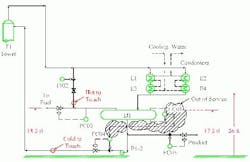Hot vapor bypass is a powerful method for controlling tower pressure. Applied correctly, it allows for rapid, sensitive and reliable control. Overall, it’s one of my favorite methods for tower control in systems with a reasonably wide boiling range of components overhead and some ability to handle a range of material in an overhead vapor product. However, hot vapor bypass has a bad reputation. Yet, problems invariably stem from lack of understanding of the control method, improper application or unintended consequences of other changes.
Unintended consequences can create major downstream problems, as one gas plant learned. Figure 1 depicts how it used hot vapor bypass for pressure control of a depropanizer tower. While not to scale, the figure shows the major equipment (tower, exchangers and drum) in the correct size ratio and identifies some critical elevations.
Figure 1. Removing a “useless” level control led to large oscillations in fuel gas supply and random flooding of the liquid drain system. (Click to enlarge.)
Originally the overhead control system included pressure control by venting overhead gas to fuel, accumulator level control by resetting reflux rate, and direct flow control of the overhead distillate liquid. The hot vapor bypass line (through flow indicator FI02) wasn’t under direct control. The bypass was regulated via a hand-operated valve. Rate through the hot vapor bypass was set by pressure balance between the flow path through the condensers and through the bypass line. The condensers drained through a line into the top of the drum D1.
This configuration has at least two major flaws:
- The top of the drum is 17.5 ft. above grade. The pressure control line to the fuel system is 18.5 ft. above grade. Unless the liquid level can be kept within that 1-ft. span, the drum can flood, sending liquid to the fuel system via the vent line. (The amount of liquid going to the fuel system depends upon the liquid height in the system, the hand control valve setting on the hot vapor bypass and the pressure control set point.)
- Liquid level varies due to changes in accumulation caused by the difference between the overhead rate from the tower and the sum of the reflux rate (FC04), product rate (FC05) and rate to fuel. Invariably, the liquid level exceeded 18.5 ft. The actual operating procedure was to keep the reflux-rate and product-rate settings constant until the unit became completely inoperable. When the level was too high, liquid would back up into the condensers until so much surface area was covered that tower pressure rose due to lack of condensation. In response the operators would increase the product rate to draw down the liquid. Flow settings were left constant until the level dropped too low. At that point the operators would reduce the product rate to refill the system.
We’ll look at this case again in future columns, as we can draw many lessons from it. For now, though, we’ll concentrate on how one specific change made the situation even worse. Due to what were reported as problems with pump net positive suction head (NPSH), the configuration was changed to deliberately flood the drum to increase the liquid head available at the suction of reflux pumps P1 and P2. This makes the level control LC01 always read 100%. Because the level controller no longer generated a usable control signal, the controller was removed from service. So, the operators no longer had a direct measure of liquid level. However, the rest of the system was left as-is. This seemingly minor change had a major unintended consequence — large oscillations in fuel gas supply and random flooding of the fuel-gas-system drip tank (liquid drain system).
Checks every morning and afternoon for three days pinpointed the problem. They all showed the system was pushing liquid into the fuel gas system. During the checks the hot vapor bypass line was always hot to the touch, indicating that large amounts of vapor were going through that line.
This miscue not only underscores the need to check control configuration against the fundamentals of the control intent but also the necessity of understanding all possible results before making operating changes.



